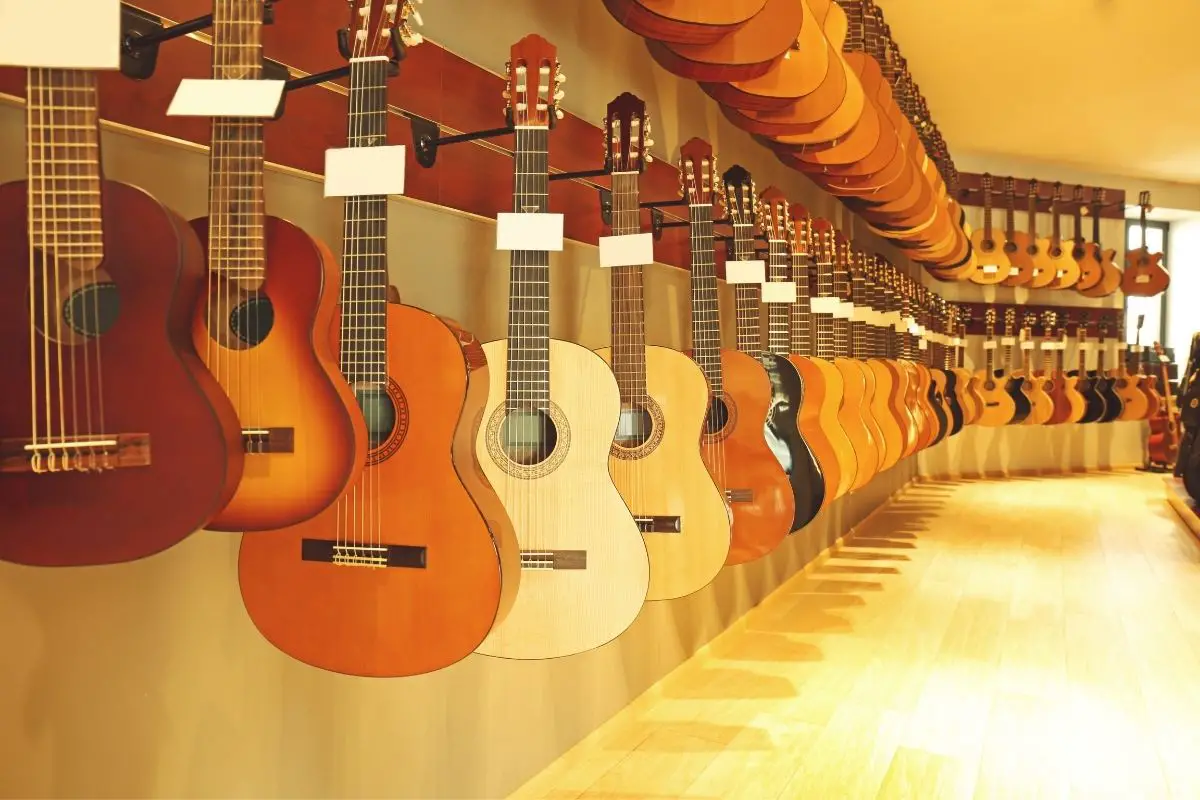How much should I spend on my new electric guitar? Should I get a full-size or a compact model? These are questions that we are very familiar with.
Choosing between a full-size and a compact guitar is a big decision. The choice depends on several factors such as the type of music you play, your budget, and your personal preferences.

Full-size guitars are larger and heavier than their smaller counterparts. They also tend to cost more.
Compact models are less expensive and lighter than full-size guitars. However, they may not have all the features available in a full-size instrument.
The most important thing when choosing a guitar is that it fits your needs. If you’re looking for a good quality instrument at an affordable price, then you need to consider what you want from your guitar. Do you plan to use it for playing rock, blues, jazz, folk, classical, country, or other styles?
What kind of sound do you prefer – acoustic, electric, or both? Will you be using it with amplification or will you just plug it into a PA system?
To learn more about different guitar models, and how to choose the right one, take a look at our ultimate guide below.
What Are The Different Sizes Of Guitars?
Guitars come in many different sizes. However, some are more common than others. Check out the most common sizes below to better understand what sized guitar is appropriate for you.
Full-Sized Guitars
Generally, a full-sized guitar has a scale length of about 25.5 inches and a total length of around 38″ long. However, this number may vary according to the style of the guitar.
A full-sized acoustic guitar is likely to be a different length from a full-sized electric guitar.
In fact, depending on the manufacturer’s design, full-sized electric guitars from different brands (Check out What Happened To Firefly Guitars?) or series may have different sizes.
This makes things a little bit confusing – we know! However, if you want to be sure that a guitar is full-sized, you should measure its scale length.
If the scale length is 25″ or longer, it is very likely that the guitar in question is a full-sized guitar.
With full-sized guitars, you have access to the regular range of the instrument – regardless of whether you opt for an acoustic or electric model.
3/4 Guitars
If the scale length of the guitar in question is between 20″ and 24″, it is likely to be a 3/4 scaled-down model. 3/4-sized guitars are a popular choice for children over 8 years old. However, they can be used by adults too.
In fact, some 3/4 versions are made specifically to be travel-friendly. They have been made for adults who take their instruments on tour or to gigs regularly.
As such, any person, child or adult, can use a 3/4-sized guitar.
1/2 & 1/4 Guitars
Now, you’re likely expecting that a 1/2-sized guitar is, well… half the size of a regular guitar. However, this isn’t the case.
Similarly, 1/4-sized guitars aren’t a quarter of the size of regular guitars. In fact, 1/4 scale guitars tend to have a scale length of around 19″.
The names aren’t trying to confuse you, rather, they are simply trying to illustrate the different available options.
Guitars that are smaller than 3/4-sized tend to be manufactured with children and teenagers in mind, so for the sake of this article, we will focus on the pros and cons of 3/4 and full-sized guitars.
Full-Sized Guitars Vs. 3/4 Sized Guitars
Now that you understand guitar sizes more clearly, let’s get into the good stuff.
Here, we discuss the benefits and downfalls of both full-sized guitars and their 3/4 sized counterparts. To figure out which one most closely suits your needs, check out the information below!
Full-Sized Guitars

To begin with, let’s take a closer look at full-sized guitars.
Scale Length
As discussed above, full-sized guitars have a scale length of around 25″ or more. Additionally, the neck of the guitar has more than 19 frets.
Whilst this does mean that the guitar itself is larger, heavier, and less portable, it also means that the player is given more freedom and has access to more tonal versatility.
Sound
It is hard to discuss the sound produced by a full-sized guitar, as this depends significantly on the style, manufacturer, and types of materials used in the production of the guitar.
Acoustic guitars and electric guitars sound completely different.
In fact, one guitar may produce a completely different tune to another, regardless of if they are both acoustic or electric or not.
However, it is generally understood that full-sized guitars do tend to produce a more full and versatile sound than that of their smaller counterparts.
String Tension
Full-sized guitars have better string tension than their smaller counterparts.
In addition to providing better playability, this also means that full-sized guitars go out of tune less quickly than smaller models. This makes them easier to maintain and play.
Quality
Obviously, the quality of the guitar, full-sized or not, depends on the quality of its construction, and the materials used in production.
However, it is fair to assume that most full-sized guitars are of better quality than smaller models. They also tend to be more durable than smaller models.
Live Performance
Following on from above, full-sized guitars generally perform better during live performances. This is a consequence of everything discussed above.
Full-sized guitars tend to produce a great, all-rounded sound, they allow for use of the full scale, and they are generally quite durable.
All of these qualities make full-sized guitars almost perfect for live performances. However, their size and weight can make them tricky to move around.
This could be a problem for musicians who are constantly carrying their instruments to different places.
Price
Finally, it is important to discuss the price. Whilst you can purchase a full-sized guitar for a reasonable price, they tend to be more expensive than their smaller counterparts.
As such, if you’re looking for a super affordable model for a beginner, a smaller model might be more appropriate.
Summary
To summarize, we’ve made a handy pro and con list for full-sized guitars. Check it out below.
Pros:
- Allow for tonal versatility.
- Produce a rich and full sound.
- Tend to be of great quality.
- Great string tension.
- Don’t require constant tuning.
- Good for live performances.
Cons:
- Heavy and large.
- Expensive.
Best Full-Sized Guitars

If you’re already convinced that you need a full-sized guitar, that’s great! Below, we’ve listed some of the best full-sized guitars available today. Check them out.
Fender FA-125 Dreadnought Acoustic Guitar
This full-sized acoustic guitar is perfect for the guitarist who is looking to step up their performance.
It produces a wonderfully full sound and allows the player to fully exercise their creativity. As a bonus, it also comes with a gig bag and a strap!
Ibanez AW540PN Artwood Dreadnought Acoustic Guitar
Ibanez is truly a tried-and-tested, world-renowned brand when it comes to the production of top-quality guitars, and this full-sized acoustic guitar is absolutely no exception!
It has a wonderful solid mahogany construction that aids in producing the richest and warmest tones.
Fender Squire Classic 70s Stratocaster Electric Guitar
If you’re looking for a top-quality, full-sized electric guitar that is reminiscent of the iconic 70s Fender models, you need to check this one out.
This Fender model is of excellent quality, and unlike many of their other instruments, it won’t break the bank!
3/4 Sized Guitars
Now, let’s move on and take a closer look at 3/4 sized guitars.
Scale Length
As mentioned above, 3/4 sized guitars generally have a scale length of around 20″ to 24″.
This does limit the tonal versatility of the instrument, and the player’s ability to play certain pieces and use certain techniques.
However, this scale length is likely to be more than enough for a beginner, a child or teenager, or an adult who plays the guitar very recreationally.
Additionally, this size also means that these sized guitars are more lightweight and portable than their full-sized counterparts.
Sound
Just as with full-sized guitars, the quality of the sound produced by 3/4 sized guitars will mainly depend on factors such as the quality of the construction, the manufacturer, and the materials used in the production.
The popular view is that 3/4 sized guitars produce a less full and less rich sound than full-sized guitars.
However, if you purchase a particularly high-quality 3/4-sized guitar, this may not be the case at all. Some 3/4 sized guitars produce a wonderfully well-rounded tone.
String Tension
Smaller guitars have less string tension than full-sized guitars. This means that you will likely have to tune smaller guitars more frequently than you would full-sized guitars.
However, low-string tension also means that it is easier to press down on the strings, which is great for beginners.
Quality
It is the general belief that 3/4 sized guitars are of lower quality than full-sized guitars. This is because they are often constructed with beginners, children, and teenage players in mind.
However, that isn’t to say that top-quality 3/4 sized guitars don’t exist – you just have to look a bit harder for them!
Live Performance
On one hand, 3/4 sized guitars are well-suited to gigging and touring, because of their lightweight and small nature.
However, if you’re performing at a large venue or to a large audience, a full-sized guitar is likely to be the better option due to the difference in the quality of the sound.
Price
Smaller-sized guitars tend to have a much more budget-friendly price tag than their larger counterparts. This makes them far more accessible for many people, particularly beginners.
Similarly, they provide an excellent option for people who don’t play the guitar religiously but still enjoy it from time to time.
Summary
To summarize, we’ve made a handy pro and con list for 3/4 sized guitars. Check it out below.
Pros:
- Lightweight and portable.
- Easier to press down on strings.
- Affordable.
Cons:
- Quality generally isn’t as good as full-sized guitars.
- The sound produced generally isn’t as full as full-sized guitars.
Best 3/4 Sized Guitars

If you’ve decided that a 3/4 sized guitar is appropriate for you, you’re in luck! Below, we’ve listed some of the best 3/4 sized guitars available today. Check them out.
Yamaha JR1 FG 3/4 Size Acoustic Guitar
This 3/4 sized acoustic guitar is a great option for beginners or young people.
It has excellent construction and produces wonderfully rich and warm tones. Yamaha is an excellent brand that ensures quality craftsmanship.
Fender FA-15 3/4 Scale Steel String Guitar
Some huge brands have now begun to produce 3/4 sized guitars, and Fender is just one of them! If you want the prestige of a fender guitar without the eye-watering price tag, this acoustic instrument is an excellent option. It also has a unique and eye-catching appearance.
Fender Squier 3/4 Mini Strat Electric Guitar
Finally, if you’re looking for a top-quality electric guitar that will suit the needs of a child or teenage learner, this Fender model is perfect.
It also comes with everything a young learner needs, including a strap, an amp, a tuner, an instrument cable, picks, an instructional DVD, and online lessons.
How To Choose Between A Full-Sized Guitar And A 3/4 Sized Guitar
If you’re still torn between the two different sizes, don’t worry! Below, we’ve included a buyers’ guide, consisting of all of the things you need to consider in order to make the most informed purchase possible.
From budget concerns to playability worries and everything in between, we cover it all! Check it out – you’ll be playing your perfect guitar in no time at all!
Age
First, it is necessary to discuss the age of the player. If you are purchasing a guitar as a gift for a child or young teenager who is a total beginner, you will likely be better off purchasing a smaller model.
A smaller model will be easier for a young child to play, and if they choose that the guitar isn’t for them, you won’t have wasted a huge amount of money.
However, if you are purchasing a guitar for an older teenager or adult who is committed to playing the guitar (whether a beginner or advanced player), it is probably necessary that you purchase a full-size model.
This will ensure that they have access to the full range of the instrument and can exercise their skills and creativity fully.
Ability
Next, it is important to consider the ability of the player. If, for instance, the player is particularly keen and hopes to play the guitar frequently, a full-sized guitar might be more appropriate for their needs, as they tend to be more durable.
However, if the player is looking for a guitar that they can pick up every now and then, without any real commitment, a 3/4 sized guitar is likely to be large and durable enough for them to fulfill their needs, and this sized guitar won’t break the bank!
Musical Goals
In addition to considering the current ability of the player, it is also necessary to consider the potential ability of the player.
For example, if you purchase a 3/4 sized guitar for a teenager who has just started learning, the instrument will work well for them in the present.
However, if that teenager begins to become a better musician, and would like to practice more difficult skills, they will likely need a guitar that allows them to use the full scale.
As such, you will end up purchasing two guitars in a short space of time.
If the player is showing a great commitment to becoming a better musician, it is necessary to purchase a full-sized guitar.
However, if the young player isn’t showing any real commitment, a 3/4 sized guitar is likely to fulfill their needs.
Preferred Genres
Whilst you can comfortably play most genres on a 3/4 guitar, if you prefer playing genres that make full use of the range of a guitar, a full-sized model is likely to work better for you.
For instance, if you hope to play classical guitar, or you cannot wait to play your favorite rock or metal solos, a full-sized guitar will be necessary.
Live Performance
If you aim to perform live, either type of guitar could work for you – it just depends on your own personal preferences.
For instance, if you aim to perform professionally to a large room or audience, a larger guitar is likely to suit you better.
However, if you enjoy playing on the street or open mic nights and would prefer a lightweight model, a 3/4 sized guitar will suit your needs perfectly.
Longevity
If you plan on purchasing a guitar that will last a long time to come, you should opt for a larger, full-sized model.
These models tend to be more durable and well-built. If, on the other hand, you aren’t too concerned about durability or longevity, a smaller model will work just fine.
Budget

Finally, it is necessary to consider your own budget.
As previously mentioned, smaller models are a lot less expensive than full-sized models.
However, if you are looking for an instrument that will suit the player’s needs as they grow as a guitarist (and potentially as a person), then purchasing a full-sized guitar the first time will prevent you from having to purchase a larger guitar in the future.
If you are confident that the player’s needs can be met with a 3/4 sized guitar, then don’t be fooled into thinking that you need a larger model.
If you’re in doubt, we recommend visiting a music store and discussing your options with trained sales assistants.
You may also want to test out a full-sized guitar and a smaller model to see which one feels more appropriate.
However, regardless of what size guitar you opt for, to ensure that you don’t get fooled into thinking you need an all-singing, all-dancing guitar with an eye-watering price tag, we recommend deciding on a final budget before you really begin shopping.
You might also find it useful to write a list of all of the features that you need, and those that you don’t, so you know exactly what to look for.
Frequently Asked Questions
If you still have some burning questions regarding guitar sizes, don’t worry!
This handy FAQ section will ensure that you are equipped with all of the necessary knowledge to purchase a guitar that is perfect for you. Check it out.
What Size Guitar Does A Child Need?
Children often require smaller guitars than adults do. The reason behind this is simple; children are smaller and weaker than adults.
As such, they require a guitar that isn’t as heavy and strings that aren’t as difficult to hold down as with full-sized guitars.
We recommend opting for a 3/4 size guitar for a child. However, depending on their age and size, they may need a 1/2 sized guitar.
If the child is under five years old, they will need a 1/4 sized guitar (or ukulele).
Should You Buy A Full-Sized Guitar For Your Child?
If your child is particularly young or small, they likely won’t be able to work with a full-sized guitar.
However, if your child is having guitar lessons, their teacher might insist that children require larger guitars to learn properly.
As such, if your child is learning classical guitar, a full-sized model is more appropriate than a smaller model.
By purchasing a full-sized model the first time around, you are also ensuring that you don’t need to purchase a second guitar in a few years once your child has grown and progressed.
Which Guitar Is Easiest To Learn On?
It is widely accepted that the acoustic guitar is easier to learn.
Whilst the electric guitar may feel easier to play and have smoother playability than the acoustic guitar, they require a lot of accessories that may be difficult to get hold of as a total beginner (amps, cables, etc).
All you need to learn the acoustic guitar is a guitar and a pick. As such, acoustic guitars are much more accessible for beginners and require little-to-no preparation to use. You simply need to be able to tune the guitar.
What Other Gear Do I Need To Learn To Play The Electric Guitar?
If you are determined to learn the electric guitar, you will need some additional equipment.
You should purchase a good-quality cable, an amplifier, a pick, a guitar tuner, guitar straps, and a guitar case (to protect your guitar when you aren’t using it).
You may also want a metronome to help you learn how to keep time, spare strings in case some of yours break, and a guitar stand to ensure that your guitar is held safely when you aren’t holding it.
You may also be interested in purchasing effects pedals to play around with as you learn.
How Do You Measure A Guitar?
The measurement of the entire guitar (from top to bottom), isn’t particularly useful. This is because this length can dramatically differ from style to style.
Instead, if you need to measure a guitar, you should measure the scale length. Regardless of style, the scale length of same-sized guitars remains fairly constant.
Can I Teach Myself To Learn How To Play Guitar?
Absolutely!
Whilst guitar lessons are ideal for children and adults hoping to learn how to play the guitar, they can be expensive and time-consuming.
As such, they aren’t feasible for everyone. Consequently, many people choose to teach themselves how to play guitar.
To do so, you will need to gather as many free or affordable resources as possible. If possible, you should purchase a guitar that comes with access to online learning courses.
You can also find an extensive number of YouTube tutorials that will help you learn how to play guitar.
If you do choose to teach yourself, you will need to be patient and consistent.
It might be hard to motivate yourself to learn if you feel as though you’ve hit a wall, however, it is very important that you practice frequently and are kind to yourself – learning the guitar takes time!
If you struggle with motivation, we recommend that you start by trying to learn one of your favorite simple songs.
Being able to play your favorite tunes is a huge reason why the guitar is such an awesome instrument to pick up. You’re more likely to stay engaged if you focus on such music.
Conclusion
Purchasing a guitar can be a very overwhelming and intimidating experience. There are so many variables to consider, and so much musical jargon to fight through!
We hope that this article has helped you understand guitar sizing better.
If you are looking to purchase a guitar, just remember, you need one that suits your specific needs.
If, after reading this article, you still feel unsure of what size is most appropriate for you, we recommend visiting a high-quality music store in person.
Such stores are equipped with super knowledgeable staff who are there to help you figure out exactly what you need.
You will also be able to try out many different guitars of different sizes, which will help you figure out what size you are comfortable with.
Finding the perfect guitar for you may take a lot of time and effort… but we promise you, it will be totally worth it!

My name is Howard Matthews and I have been playing the guitar since I was knee-high. My parents like to joke that I was pulling the strings even before I was born. In fact, one of my earliest memories is sitting on the couch with my dad’s guitar, wreaking havoc on the chords.
Now, 40 years later, I can attest that I play them much better than I did back then. I have followed in the footsteps of both my parents – much to their delight – and have been the main guitarist in my band for the best part of three decades.
Music has always been my passion, and until recently my life has been so consumed with it that I haven’t had a moment to have a breath (and I wouldn’t have it any other way)!








